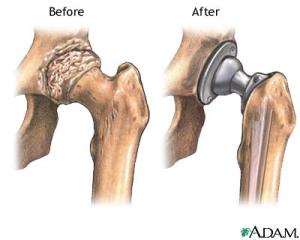Oct 8 2010
Foreign material in the human body, such as implants for hip and knee joints, can be enhanced by ongoing biotribologisk research on lubrication, abrasion and friction. Researchers at Luleå University of Technology can reduce the frequency of painful hip operations and reduce healthcare costs by their research.
Our research will take a major step forward when our research team will be strengthened with a total of three PhD’s. We will focus on three different projects including new reinforced materials using nano-particles, "said Nazanin Emami leading research in biotribologi within the Division of machine elements at Luleå University of Technology.
 The picture shows before and after a hip operation. In the right image is the artificial hip joint implanted. In it are various tribological processes (friction, lubrication and abration) which is the subject of interest for the researchers.
The picture shows before and after a hip operation. In the right image is the artificial hip joint implanted. In it are various tribological processes (friction, lubrication and abration) which is the subject of interest for the researchers.
Two female PhD’s have recently been employed, and Nazanin Emami hopes to attract more women who want to do research on biotribologi. The past 50 years, hip implants had a major role for patients with hip problems. After surgery, they have been able to live a normal life. It is a very common and successful surgery in the world, but there are problems. In theory, a hip implant would function throughout life, but in reality it is sustainable only 12-15 years. Approximately 6-10% of all patients in Sweden who undergo surgery, has to be re-operated. It’s a painful surgery for the patient when the old implant is removed, and enormous cost for the society.
- This is where our research comes into play. We want to extend the life of the implant, said Nazanin Emami
Luleå University of Technology carries out three different projects in the area, in cooperation with Umeå University through the Center for Biomedical Engineering and Physics (CMTF), Leeds University, UK, Aveiro University in Portugal and with different companies. Hip and knee implants is the subjects that researchers focus on. A hip implant is usually made of metals, of which one part is attached to the lower leg (upper thigh) and in its upper part has a bullet in the head (ceramic or metallic) that moves towards a bowl of polymer that is secured in a holder in the hip bone. One of the projects is to reinforce polymers using nanoparticles and bio molecules.
- Our research has come forward a bit and when we have the new composite it will be tested tribological to comparative materials, "she says.
This means, e.g. to find out how the new material works with metals (chromium-cobalt alloy) or ceramic, and with synovial fluid, which is the body's natural lubricant. The second research project is for example to investigate the biological effects of small particles that come off the abrasion of the two different materials and the third project is to investigate the erosion or corrosion, of a new material for implants.
Source: http://www.ltu.se/